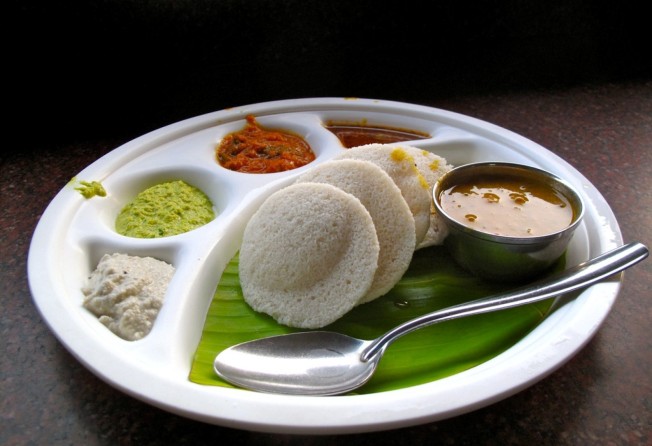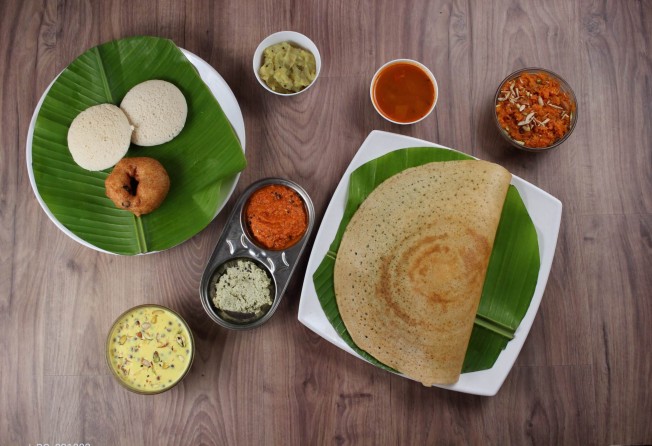
From Udupi to Hong Kong: how an Indian temple town’s vegetarian cuisine spread across the world
- Multiple chains and franchises across the country – and the world – can trace their origins to food prepared in the kitchens of the town’s Lord Krishna temple
- While menus have been updated over the years as appetites change, traditional Udupi fare is still a draw for those looking for a wholesome, healthy meal

Mentioning Udupi cuisine triggers a vivid memory for Rakesh Raghunathan. “The most amazing dish that I have had at a Udupi restaurant is at the old Dasaprakash Hotel in Mysore, where they served haalbai, a halwa made with rice flour, jaggery, coconut milk and ghee,” the Chennai-based food raconteur and television host says. “I can still remember that melt-in-the-mouth goodness years later.”
Raghunathan isn’t alone. Even people who live in Indian cities hundreds of kilometres away, such as Chennai and Bangalore, remember their inexpensive meals over the years at Udupi restaurants such as Woodlands and Dasaprakash – where white-uniformed waiters wearing caps serve mounds of rice, drizzled with ghee; three vegetables seasoned with curry leaves and coconut; a tangy lentil stew called sambar; watery, peppery rasam soup; and mango pickles, with crunchy papads.
The dusty temple town of Udupi – between the Western Ghats and the Arabian Sea, close to the city of Mangalore, lashed by monsoons for four months of the year – has spawned countless Udupi-style vegetarian restaurants around the world, from Dubai to New York.
Raghunathan explained that the beginnings of Udupi-style cuisine were in the 13th century, when a caste called the Shivalli Brahmins made elaborate food in the kitchens of the Lord Krishna temple.

The offering to Krishna, one of the Hindu pantheon’s most widely revered deities, involved no less than 14 different cooked delicacies each day. The food was also served to devotees who thronged the temple throughout the year.
“The food that was served here was essentially satvik [foods that are ripened and harvested according to nature, and promote harmony] and had to be cooked with many religious restrictions, which banned the use of onions and garlic, root vegetables like potatoes and even ‘English vegetables’ like cauliflower and radish. Seasonality was key and there was a list of things that would not be eaten during the monsoon months.”
In the 1920s, restaurants sprang up in the town serving simple Udupi temple fare – mostly lentils and other vegetables, seasoned with freshly ground spices and sweetened with a pinch of jaggery. Local produce featured prominently, such as mattu gulla, a type of green-skinned brinjal, as well as gourds, plantains, white pumpkin, and seasonal greens.
With the advent of grinding and steaming techniques and equipment, Udupi food also expanded to include tiffin – including masala dosas, crisp lentil crepes stuffed with a spiced potato mixture, and moon-shaped idlis made from fermented rice and lentil batter, served with sambar and chutney.
The region has some very special dishes such as kadubu idlis (lentil and rice batter steamed in conical moulds) and goli baje – deep fried fritters of flour and curd with a smattering of green chillis and ginger. Thanbulis are another local speciality – cucumber or other greens cooked and then mixed with buttermilk and seasoned with mustard and curry leaves.

After a major flood in 1923 devastated Udupi, many cooks from the town moved to bigger cities such as Chennai and Mumbai, opening Udupi restaurants that came to be known for their wholesome fare, cheap prices and clean dining rooms. In the beginning they had separate dining sections for Brahmins, but with increasing activism against caste discrimination in the 1960s, the Udupi restaurants became more secular and allowed people from all castes and religions to dine there.
A year later, three brothers from the Maiya family moved from Udupi to Bangalore to work in a British judge’s house as cooks. They went on to set up an unpretentious restaurant called Brahmin Coffee House that served idlis and filtered coffee. In 1950, they set up Mavalli Tiffin Rooms (MTR), which has grown from a restaurant to a food enterprise that is today a giant in the world of Udupi cuisine, with branches overseas as well as a popular line of packaged foods.
“The Udupi brand of course has been diluted with many people using it randomly from Goa to Patna, making rock hard idlis and terrible dosas. We have tried to be close to the original cuisine from Udupi but of course the food has evolved to include elements of Mysore kitchens and of North Karnataka,” says Vikram Maiya, a third-generation restaurateur from the family who now runs MTR with his siblings.
“But the sambar and rasam that we serve is quintessentially Udupi style. We have franchises in Singapore, Malaysia and Dubai and have adapted our menus to local tastes. Ultimately a sensible brand adapts to consumer preference.”

With simply decorated rooms where anybody from a single woman to an office worker could sit and have an inexpensive homestyle meal, Udupi restaurants became institutions in cities across the country. Today, many Udupi restaurants have moved with the times and offer North Indian dishes and desserts. Many serve food with a slice of nostalgia – they are still family run, and old fashioned in their decor.
Bollywood star Priyanka Chopra’s New York restaurant Sona has an Udupi connection – culinary director and executive chef Hari Nayak hails from the town. In Hong Kong’s Tsim Sha Tsui neighbourhood, Woodlands Indian Vegetarian Restaurant, founded in 1981, serves everything from vegetarian thalis to dosas and idlis.
Arun PE, who took over Woodlands in 2018, said it was the only Udupi-style restaurant in the city, where ethnic minorities account for about 8 per cent of the population.
“Our chefs are from Udupi itself and have been with us for over 25 years,” he said proudly.
Udupi itself is still a sleepy coastal town steeped in religion and food. Every day, the Sri Krishna Temple serves free food on banana leaves to visiting devotees. Small stalls sell fresh tiffin in the streets around the temple. There are no signs of the vast culinary empire that started in its bustling kitchens.
The Dasaprakash chain of restaurants was started by another Udupi native, K. Seetharama Rao, who in 1921 joined his brother’s tiffin business in the southern city of Mysore. K. Vishwanatha Das, who runs the chain with his family, says they now offer other cuisines, from North Indian to Chinese and even European, to suit customers’ preferences – but it’s the flavour of Udupi that keeps them coming back.
“The authentic taste of Udupi cuisine was the freshly ground spices and the use of firewood for cooking. We still use a lot of jaggery to give the food a hint of sweetness,” he says. “It’s traditional food which will always have a demand because it’s wholesome, healthy and nutritious.”